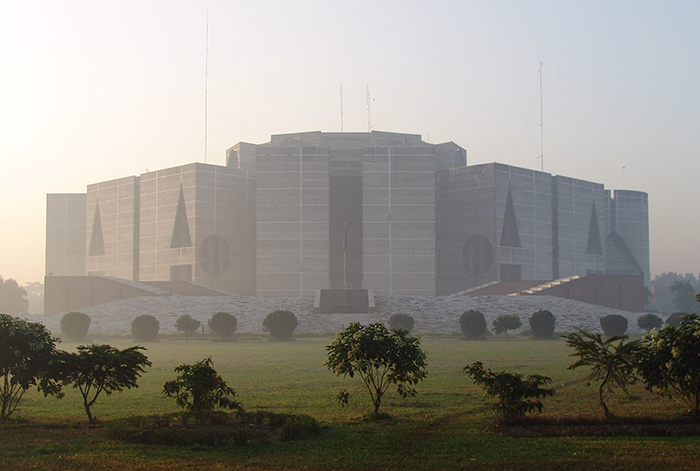Architects and architecture seem especially well suited to the cinema. Think of the final scene of The Fountainhead (1949), with architect Howard Roark (played by Gary Cooper) standing triumphantly atop the skyscraper he has designed and built without compromising his integrity. Or almost any scene in The Belly of an Architect (1987) in which the classical architecture of Rome in perfect symmetry envelops architect Stourley Kracklite (played by Brian Dennehy). However, what may be my favorite moment in any film about architecture comes toward the conclusion of My Architect: A Son’s Journey (2003), a documentary directed by Nathaniel Kahn about his father, the magnificent modernist architect Louis Kahn (1901–1974).
In this scene, Nathaniel visits for the first time what was his father’s crowning architectural achievement, completed posthumously in 1982: the Jatiyo Sangsad Bhaban (or National Assembly Building) in Dhaka, the capital of Bangladesh. This scene, which can be watched here, begins with shots of the Ganges River in Bangladesh and then comes upon the massive structure itself, made of reinforced concrete, reflected in an artificial lake. When Nathaniel enters the building, the camera follows him, moving gracefully through the corridors, tilting up to rays of light beautifully streaming through the coffered dome of the Parliament Chamber.

The Bangladeshi architect Shamsul Wares, who worked directly with Louis Kahn, summarizes the project’s significance for the people of Bangladesh: “It was almost impossible, a building for a country like ours. Thirty, fifty years back, it was nothing, only paddy fields. And since we invited him here, he felt that he has got a responsibility….He didn’t care for how much money this country has, or whether he would ever be able to finish this building, but somehow he has been able to do it, build it here. And this is the largest project he has—in here, the poorest country in the world. He paid his life for this. That is why he is great and we’ll remember him…. He has given us this building and we feel all the time for him. That’s why he has given love for us. You have to understand that. He had an enormous amount of love. He loved everybody. To love everybody, he sometimes did not see the very closest ones.”
Wares’s final sentence refers to Louis Kahn’s extraordinarily complicated personal life, serving as father to three children—all born to different mothers, two of them (Nathaniel and his half-sister) excluded from the obituaries written after Kahn died of a sudden heart attack, alone in New York’s Pennsylvania Station.
But if Kahn’s personal life was complex, his architectural achievements—such as the National Assembly Building—succeed because of their simplicity: the simplicity of materials, primarily concrete and brick; the simplicity (or rather the relative lack) of ornamentation, as befits many modernist buildings; and the simplicity of design, which in the case of the National Assembly Building was borrowed in part from elements of traditional architecture of Bangladesh.

For instance, the repetition of circles, triangles, and rectangles on the building’s facades are reminiscent of traditional Bangladeshi geometrical motifs, commonly seen on structures, pots, weavings, and much more. The building’s bold use of exterior light—not only to illuminate but also to help define space within the structure—is similarly emblematic of Bangladeshi culture. In his masterful study Art and Life in Bangladesh (1977), the preeminent folklorist Henry Glassie describes the significance of light for the people and culture of Bangladesh: “In the Muslim view, God is beautiful, and God’s beauty collects beauty. The likeness of God is light…. The bright artifact that attracts and reflects light is a symbol of proper behavior. As a person should, the object accepts God’s light and casts it back, unifying with nature’s beauty” (418). The same interplay of light and beauty is what Kahn himself may have been seeking when he wrote: “In the assembly I have introduced a light-giving element to the interior of the plan…. I am working to develop the element to such an extent that it becomes a poetic entity which has its own beauty outside of its place in the composition.”
Unfortunately, Kahn never lived to see this architectural masterpiece completed. But I’m very glad that his son Nathaniel was able to bring back words and images from the National Assembly Building, which help us better appreciate the genius not only of Louis Kahn but also of traditional Bangladeshi culture. I’ve already started to think about my own trip to Dhaka.
James Deutsch declared at a school assembly in the sixth grade that he wanted to be an architect when he grew up. He is now a program curator at the Center for Folklife and Cultural Heritage.


